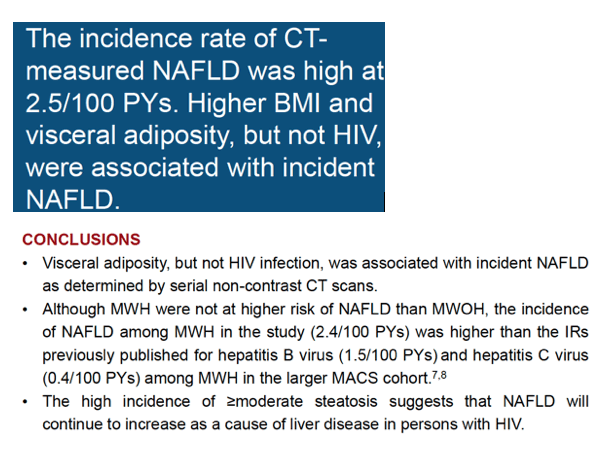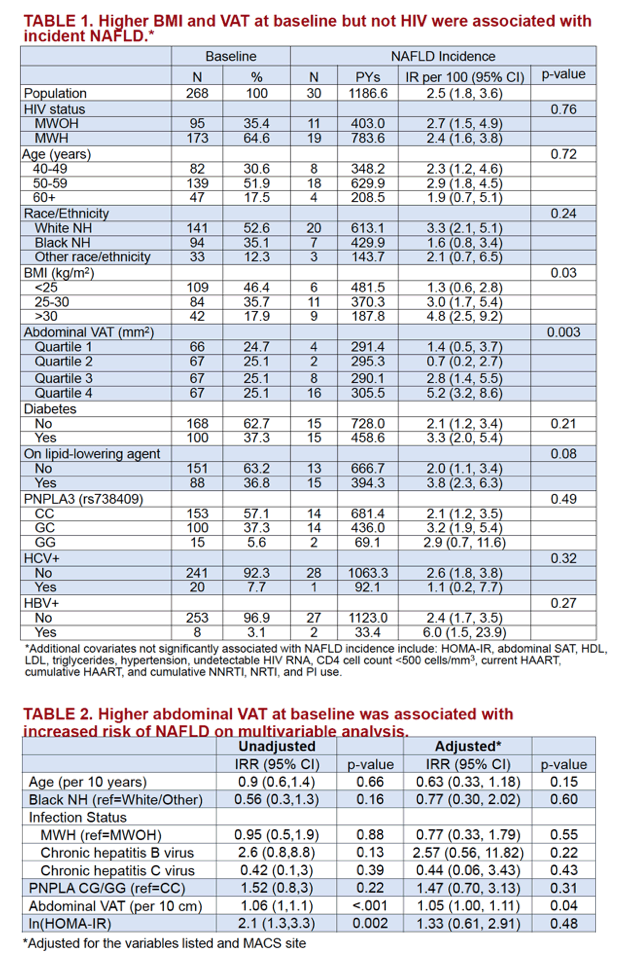 |
 |
 |
| |
11% - HIGH INCIDENCE RATE OF CT-MEASURED NAFLD IN MACS MEN WITH AND WITHOUT HIV INFECTION
|
| |
| |
Although MWH were not at higher risk of NAFLD than MWOH, the high observed IR of NAFLD relative to previously published IRs of hepatitis B and C among MWH in the same cohort suggests that NAFLD will continue to increase as cause of liver disease in PWH.

CROI 2022 Feb 11-16
Jennifer Price1, Gayle Springer2, Eric C. Seaberg2, Matthew Budoff3, Susan L. Koletar4, Claudia Hawkins5, Mallory Witt6, Wendy Post7, Chloe L. Thio7
1University of California San Francisco, San Francisco, CA, USA, 2The Johns Hopkins Bloomberg School of Public Health, Baltimore, MD, USA, 3Harbor–University of California Los Angeles Medical Center, Torrance, CA, USA, 4The Ohio State University, Columbus, OH, USA, 5Northwestern University, Chicago, IL, USA, 6Los Angeles Biomedical Research Institute at Harbor–UCLA Medical Center, Torrance, CA, USA, 7The Johns Hopkins University School of Medicine, Baltimore, MD, USA
Background:
Nonalcoholic fatty liver disease (NAFLD) can progress to cirrhosis, hepatocellular carcinoma, and end-stage liver failure. Although NAFLD has become a major cause of liver disease including among persons with HIV (PWH), few studies have examined NAFLD incidence in PWH. We aimed to determine NAFLD incidence among PWH and persons without HIV (PWOH) within the Multicenter AIDS Cohort Study (MACS), a prospective cohort of men who have sex with men.
Methods:
MACS participants were included if they had two non-contrast cardiac CT scans with complete visualization of the liver and spleen, consumed on average <3 alcoholic drinks daily and had stored cells for DNA extraction for PNPLA3 testing. Baseline CT scans were performed from 2010-2013 and follow-up scans from 2015-2017. Incident NAFLD was defined as men without hepatic steatosis at baseline who had steatosis (liver/spleen Hounsfield unit ratio <1.0) at follow-up. Visceral adipose tissue (VAT) was measured in one axial image obtained between the 4th and 5th lumbar vertebrae, and the homeostatic model assessment of insulin resistance (HOMA-IR) was calculated using 8-hour fasting insulin and glucose values. Incidence rates (IRs) were calculated using a person-years (PYs) analysis. Generalized linear regression models were used to determine factors associated with incident NAFLD.
Results:
In total, 268 men were eligible: 173 men with HIV (MWH) and 95 men without HIV (MWOH), with median age 57 years (IQR 53-62), 53% White and 35% Black. Median time between CT scans was 4.5 years (IQR 3.8-5.0). Thirty men had incident NAFLD (11.1%), with an overall IR of 2.53 /100 PYs (95% CI 1.77, 3.62): IR 2.42/100 PYs (95% CI 1.55, 3.80) for MWH and 2.73/100 PY (95% CI 1.51, 4.93) for MWOH (p=0.75). The IRs for lean (BMI<25 kg/m2) and non-lean (BMI≥25 kg/m2) men were 1.25/100 PYs (95% CI 0.56, 2.77) and 3.58/100 PYs (95% CI 2.31, 5.56), respectively (p=0.02). In multivariable analysis, higher abdominal VAT was associated with increased risk of NAFLD (Table).
Conclusion:
Visceral adiposity, but not HIV infection, was associated with incident NAFLD as determined by serial non-contrast CT scans.
Although MWH were not at higher risk of NAFLD than MWOH, the high observed IR of NAFLD relative to previously published IRs of hepatitis B and C among MWH in the same cohort suggests that NAFLD will continue to increase as cause of liver disease in PWH.



|
| |
|
 |
 |
|
|